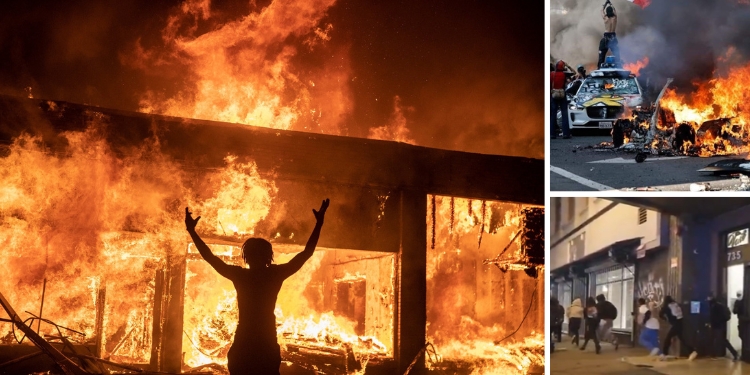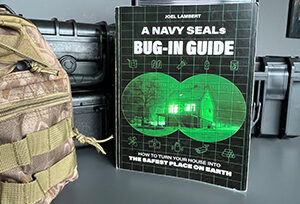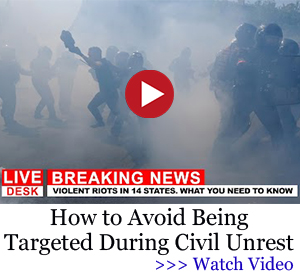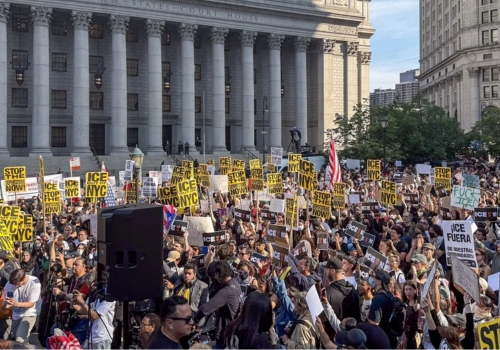L.A. Is Just the Beginning

What started with a handful of federal raids has now pushed Los Angeles to the edge. Since June 6, 2025, the city has been gripped by mass unrest after Immigration and Customs Enforcement (ICE) agents targeted multiple businesses suspected of employing undocumented immigrants. These were full-scale operations, carried out in broad daylight, in areas like the Fashion District and Westlake. And the L.A. protesters’ response was explosive.
Demonstrators flooded downtown streets, blocking key routes and occupying intersections. The city’s central core has become a conflict zone. Vehicles have been torched – including several self-driving units – rocks and fireworks hurled at law enforcement, and federal buildings are now under constant guard. While the situation hasn’t escalated into all-out citywide collapse yet, tensions are rising by the hour.
L.A. Protesters Clashed with The Police
Violent clashes between protesters and law enforcement have turned large parts of Los Angeles into a war zone. Arrests are mounting as individuals are charged with arson, assault, looting, and other high-impact crimes.
Streets once crowded with traffic are now blocked by debris, torched vehicles, and police barricades. Stores have been ransacked and shuttered, some burned beyond recognition. Supply trucks can’t get through. Delivery routes are frozen. And the city’s emergency response system is cracking under pressure.
Federal troops have been deployed onto city streets, including National Guard units and active-duty Marines. And they didn’t wait for the governor’s approval. The White House acted unilaterally, bypassing state authority. In response, California’s top officials pushed back hard, challenging the move in federal court and accusing the administration of overreach. Now you have state leaders and federal agencies locked in a legal standoff – while the city burns behind them.
As of June 13, 2025, this chaos shows no signs of slowing down. What began as backlash against immigration enforcement has spiraled into full-blown civil unrest. Waymo – one of the largest autonomous vehicle companies in the nation – has pulled its entire fleet from L.A., citing safety concerns and multiple cases of vandalism.
If this spreads beyond city limits or intensifies within them, expect a chain reaction. Fuel and food shipments could be cut off. First responders may not be able to reach those in need in time. Power outages, communication breakdowns, and targeted attacks on infrastructure could follow. This is a glimpse into how quickly a modern American city can slide into chaos.
L.A. Protesters Set The Tone. Other States Where Protests Are Already Underway
The fire that ignited in Los Angeles is now moving across the country. Cities in at least a dozen states have begun to see street actions, mass gatherings, and growing unrest. While things haven’t fully erupted in these locations, but the patterns look hauntingly familiar.
New York (New York City)
Mass gatherings erupted around Foley Square, Trump Tower, and multiple federal buildings. Police presence intensified as demonstrators took over busy intersections and government property. Chants rang out, and tensions between law enforcement and the public mounted with each passing hour.
Illinois (Chicago)
Demonstrators marched through the Loop and Federal Plaza, waving signs and chanting slogans denouncing immigration enforcement and federal intervention. While the surface may seem controlled, isolated incidents of vandalism and hostile confrontations hint at deeper instability.
Texas
- San Antonio: Large crowds formed outside City Hall. The Texas National Guard was mobilized—without prior notice to the city’s mayor. Tensions between state and local officials are simmering.
- Austin: Crowds stormed the Texas State Capitol and marched toward the J.J. Pickle Federal Building. Clashes with authorities left multiple injuries. Police deployed chemical irritants as the situation became unstable.
- Dallas: Protesters shut down intersections, prompting swift police crackdowns.
- Houston: Crowds marched through key arteries, disrupting business districts and federal facilities.
Washington (Seattle)
Demonstrators blocked entryways to federal immigration courts. Law enforcement intervened quickly, but more actions are already planned in defiance of police presence.
Georgia (Atlanta)
Marches on Buford Highway have intensified. While relatively contained so far, the mood is shifting. The possibility of flare-ups is growing as communication with protest organizers in Los Angeles increases.
Colorado (Denver)
Major traffic disruptions and clashes near Coors Field signal a city on edge. Protest groups are calling for a full shutdown of government operations if raids continue.
Pennsylvania (Philadelphia)
Demonstrators are targeting courthouses and police precincts. Local authorities report injuries and increasing hostility. Unions have joined the protests, adding fuel to the fire.
Nebraska (Omaha)
Following reports of an ICE raid on a meat-packing facility, hundreds poured into the streets. Government vehicles have been vandalized, and calls for escalation are spreading on local forums.
Other Flashpoints: Reports of similar actions in Boston, San Francisco, Las Vegas, Sacramento, Portland, and Washington D.C. are already surfacing. Most cities are seeing waves of small but increasingly aggressive protests, coordinated across encrypted channels and social media.
Key Pattern: These are not random. The timing, language, and tactics reveal coordination. National organizers have already announced a “No Kings” campaign for June 14, with events scheduled in all 50 states
States at Risk for Expansion
While the hotspots above are already active, other states are teetering on the edge:
- Florida – With its large metro zones and history of political volatility, Florida could explode if federal forces take action in Miami or Tampa. Tensions are high, and activists are organizing.
- Nevada – Las Vegas has already seen minor flare-ups. If a single federal facility is targeted, widespread disruption could follow.
- Arizona – With its border proximity and history of enforcement crackdowns, Arizona remains a powder keg. Tucson and Phoenix are key zones to watch.
- North Carolina – Charlotte and Raleigh are experiencing protest buildup. State leadership has been silent, but behind-the-scenes communication among organizers is increasing.
- Missouri – St. Louis is showing early warning signs. Coordinated protest events are being planned for mid-June.
The question is no longer if these states will join the unrest, but when.
What Happens Next? Martial Law or Civil War?
To be perfectly honest, at this point, the only questions you should be asking are “How fast is this going to spiral?” and “How close is it to my doorstep?”. You’ve seen unrest before. You’ve watched cities burn, leaders argue, and the news cycle spin it all into noise. But this isn’t noise. What’s happening now is something different. This is a breakdown of control, layer by layer, and if you’re not paying attention, you’re going to get caught flat-footed.
Martial Law Is No Longer a Hypothetical
For years, the idea of martial law in America has felt like something reserved for dystopian fiction or third-world headlines. Not anymore. What’s happening right now in Los Angeles should make you stop and think. The shift from protest to full-blown lockdown is already underway.
As of June 12, 2025, downtown Los Angeles is under a strict curfew, and thousands of federalized National Guard troops and active-duty Marines have been deployed in the streets. Helicopters circle overhead. Armored vehicles block intersections. Checkpoints are being tested. The city isn’t under martial law yet, but it’s dangerously close.
When it finally happens, life changes fast. Federal troops don’t answer to your mayor or your governor. If they decide your neighborhood needs to be “secured,” you may find your streets patrolled day and night, movement restricted, homes searched without warning, and communications blacked out. You won’t get to ask questions. You also won’t get time to prepare. That time is now…
Los Angeles might just be the proving ground. If the system flips here, it sets the stage for the same playbook to roll out across the country.
Civil War: Not the Kind You’re Expecting
This isn’t about a political party or who’s sitting in the Oval Office. It’s about a breakdown in control. What’s happening in Los Angeles right now isn’t just a protest, it’s a flashpoint. One where federal authority, state resistance, and urban chaos are colliding all at once. And the friction is heating up.
Federal troops are in the streets. State officials are pushing back. Protesters are targeting infrastructure and clashing with law enforcement. Entire stretches of freeway are being blocked, vehicles torched, and critical services delayed or disabled. Supply routes are vulnerable. Hospitals are overwhelmed. Businesses are folding under pressure. And what little control remains is slipping by the hour.
This is what the early stages of civil conflict look like. There are fractures forming in real time: cities rejecting federal orders, governors fighting back, armed civilians stepping into the void left by fractured authority. And what comes next is not hard to imagine:
- Military units caught between conflicting orders
- Armed groups defending their neighborhoods
- Strategic targets – power grids, fuel depots, comms towers – suddenly “offline”
- Local governments sealing off roads, refusing to cooperate with federal mandates
All it takes is one miscalculation, one overreaction, and the dominoes start to fall. The truth is simple: Los Angeles may already be past the tipping point. And if that’s true, the rest of the country isn’t far behind.
Are you ready to live in a world where your next supply run could be blocked by troops with no badge and no accountability? Where your town is split between those who follow the Constitution and those who follow orders? Where your home becomes your last line of defense, and your gear, training, and readiness are the only things that matter?
What You Must Do Right Now
As I told you earlier, if things truly spiral out of control, it’s going to happen fast. In other words, you won’t have time to get ready once it starts. That’s why you need to prepare now. Here’s what you should do, without any delay:
Check Your Supplies
When a major crisis hits – which looks more inevitable by the day – the first things to break down will be your basic necessities: food, water, electricity, and medical care. If you’re not prepared, you’re risking your life. And not just your own—but your family’s too. So here’s what you need to do right now, without delay:
- Secure your water supply – If the municipal water grid collapses or becomes contaminated, it’s only a matter of days before things get deadly. The human body simply can’t survive without clean water. There’s no substitute and no trick to stretch it. That’s why water should be your number one priority. One of the simplest solutions is this backpack-sized water generator. It’s small, affordable, and highly effective, pulling moisture from the air and turning it into up to 40 gallons of pure water per day.
- Stock up on food – If you haven’t done this yet… well, you’re cutting it dangerously close. But there’s still time. Stores are still open for now (unless that changes by the time you’re reading this), so get what you can. If you need help building a crisis-ready food stockpile, this will guide you step by step on how to build one that keeps your family fed through extended emergencies.
- Go off-grid – Take a page from the Amish community and learn how to generate your own electricity, cook without gas, and keep your home running when everything else shuts down. When society collapses, the ones who thrive will be the ones who never needed it in the first place. Also, make sure you have a solid grasp of basic first aid measures, as well as natural remedies, treatments, and ways to stockpile essential antibiotics without a prescription.

Secure Your Home
When hell breaks loose, the last thing you want is for your home to become a target. This is your final fallback. You’ll depend on it for safety, resources, and survival. So you’d better make sure it’s protected. Where’s the threat coming from? Well, basically everyone. From desperate neighbors and unprepared looters to roaming gangs or even out-of-control authorities – your home needs to be defended.
If you want a real chance of surviving a home invasion during a crisis, consider using this complete Anti-Looter Kit. It’s designed to give you everything you need to deter, delay, and defend against any unwanted intrusion. And if things get even worse, make sure you’re equipped with advanced home defense tactics, this guide shows you exactly how to hold your ground when it matters most.
Review Your Bug-In Strategy
 Even if you’ve taken some prepping steps already, let’s be honest: what’s happening right now is probably beyond what you imagined. It’s getting real, fast. So it’s time to reassess. Look at your plan with fresh eyes and upgrade it. The smartest move you can make?
Even if you’ve taken some prepping steps already, let’s be honest: what’s happening right now is probably beyond what you imagined. It’s getting real, fast. So it’s time to reassess. Look at your plan with fresh eyes and upgrade it. The smartest move you can make?
Follow a proven roadmap, like A Navy SEAL’s Bug-In Guide, created by Joel Lambert, America’s most renowned former Navy SEAL. This isn’t guesswork. It’s field-tested insight from someone who’s operated behind enemy lines. Inside, you’ll find battle-ready answers to questions most people don’t even think to ask:
Choose a Bug-Out Location
Let’s be clear: there’s no guarantee this chaos will stay contained. Things might spiral fast. And when they do, your home – no matter how secure – might not be safe anymore. That’s why you need a bug-out location. Somewhere rural, off the radar, and stocked in advance. If possible, get it ready now. Move supplies there, protect your privacy, and tell no one. The fewer people who know, the safer you’ll be.
If owning a bug-out location isn’t possible, then your next best bet is learning to survive in the wild. If you’re forced to flee, knowing how to build a shelter, find water, and make fire on the spot could mean the difference between life and death. For that, Wilderness Survival Guide by renowned survivalist Nicole Apelian is a must-have. When SHTF, this is the first thing you throw in your bug-out bag.
Remember: knowledge doesn’t weigh anything, but it can save your life. And your family’s.
Final Thoughts
It’s already crystal clear that Los Angeles was not an isolated incident. It was a test case. The conditions that sparked LA’s unrest are present in dozens of major cities and states across America. Political polarization, economic stress, anti-law enforcement sentiment, and mass illegal immigration have created a fragile national situation. What’s your plan, in case things escalate even further? Hop in the comments and let’s talk about it!
You may also like:

This Is How I Am Going to Stay Safe During the Upcoming Riots
Worst States to Be in When the Economy Collapses
Hidden Signs Your Neighbor is a …
The Police and Military when SHTF – Friend or Armed Foe?
Read the full article here










